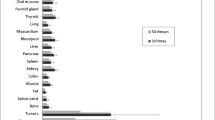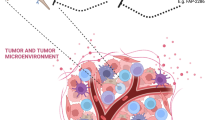Abstract
Introduction
The unique expression pattern of fibroblast activation protein (FAP) in stromal and tumor cells, particularly in sarcomas, and its absence in normal tissues, have positioned it as a promising theragnostic approach for the detection and treatment of various cancer types. The objective of this prospective study is to assess the feasibility, safety, biodistribution, and therapeutic efficacy of [177Lu]Lu-FAPI-2286 in patients with advanced metastatic sarcoma.
Patients and Methods
Eight patients with advanced metastatic sarcoma, who were unresectable or had experienced disease recurrence following conventional treatments, underwent PTRT (peptide-targeted radionuclide therapy) using [177Lu]Lu-FAPI-2286. Prior to the treatment, confirmation of tumor uptake was obtained through [68Ga]Ga-FAPI-2286 PET/CT.
Results
After four cycles of PTRT with [177Lu]Lu-FAPI-2286 (6660–7400 MBq), with a 6-8-week interval between each cycle, no grade 3 or 4 side effects were observed in the patients, and the treatment was well tolerated by all participants. The results demonstrated a 52.37% reduction in the average volume of the primary tumor, accompanied by a significant decrease in SUVmax and TBR of the metastatic lesions (29.67% and 43.66% respectively), especially in cases of lung metastasis. Furthermore, besides the improvement in physical capacity, there was a noticeable reduction in pain, an increase in overall survival, and enhanced satisfaction with the treatment reported by the patients.
Conclusion
[177Lu]Lu-FAPI-2286 PTRT, utilized for diverse cancer types, exhibited favorable tolerability in sarcoma patients, with minimal side effects, long-lasting retention of the radiopeptide within the tumor, and promising therapeutic effects. Preliminary findings of this prospective study need to be confirmed through further clinical trials.


Similar content being viewed by others
Explore related subjects
Discover the latest articles and news from researchers in related subjects, suggested using machine learning.Data availability
All data generated or analyzed during this study are included in this published article.
References
De P, Aske J, Dey N. Cancer-Associated Fibroblast functions as a Road-Block in Cancer Therapy. Cancers. 2021;13:5246.
Liu R, Li H, Liu L, Yu J, Ren X. Fibroblast activation protein: a potential therapeutic target in cancer. Cancer Biol Ther. 2012;13:123–9. https://doi.org/10.4161/cbt.13.3.18696
Zboralski D, Hoehne A, Bredenbeck A, Schumann A, Nguyen M, Schneider E, et al. Preclinical evaluation of FAP-2286 for fibroblast activation protein targeted radionuclide imaging and therapy. Eur J Nucl Med Mol Imaging. 2022;49:3651–67.
Puré E, Blomberg R. Pro-tumorigenic roles of fibroblast activation protein in cancer: back to the basics. Oncogene. 2018;37:4343–57. https://doi.org/10.1038/s41388-018-0275-3
Fitzgerald AA, Weiner LM. The role of fibroblast activation protein in health and malignancy. Cancer Metastasis Rev. 2020;39:783–803. https://doi.org/10.1007/s10555-020-09909-3
Pang Y, Zhao L, Meng T, Xu W, Lin Q, Wu H, et al. PET imaging of fibroblast activation protein in various types of Cancer using (68)Ga-FAP-2286: comparison with (18)F-FDG and (68)Ga-FAPI-46 in a Single-Center, prospective study. J Nucl Med. 2023;64:386–94. https://doi.org/10.2967/jnumed.122.264544
Lindner T, Altmann A, Krämer S, Kleist C, Loktev A, Kratochwil C, et al. Design and development of (99m)Tc-Labeled FAPI Tracers for SPECT Imaging and (188)re therapy. J Nucl Med. 2020;61:1507–13. https://doi.org/10.2967/jnumed.119.239731
Assadi M, Rekabpour SJ, Jafari E, Divband G, Nikkholgh B, Amini H, et al. Feasibility and therapeutic potential of 177Lu–Fibroblast activation protein Inhibitor–46 for patients with relapsed or refractory cancers: a preliminary study. Clin Nucl Med. 2021;46:e523–30.
Baum RP, Schuchardt C, Singh A, Chantadisai M, Robiller FC, Zhang J, et al. Feasibility, biodistribution, and preliminary dosimetry in peptide-targeted radionuclide therapy of diverse adenocarcinomas using 177Lu-FAP-2286: first-in-humans results. J Nucl Med. 2022;63:415–23.
Sidrak MMA, De Feo MS, Corica F, Gorica J, Conte M, Filippi L, et al. Fibroblast activation protein inhibitor (FAPI)-Based theranostics-where we are at and where we are heading: a systematic review. Int J Mol Sci. 2023;24. https://doi.org/10.3390/ijms24043863
Banihashemian SS, Divband G, Pirayesh E, Nikkholgh B, Amini H, Shahrnoy AA, et al. [(68)Ga]Ga-FAP-2286, a novel promising theragnostic approach for PET/CT imaging in patients with various type of metastatic cancers. Eur J Nucl Med Mol Imaging. 2024. https://doi.org/10.1007/s00259-024-06635-8
Giammarile F, Knoll P, Paez D, Estrada Lobato E, Calapaquí Terán AK, Delgado Bolton RC. Fibroblast activation protein inhibitor (FAPI) PET imaging in Sarcomas: a New Frontier in Nuclear Medicine. Semin Nucl Med. 2024. https://doi.org/10.1053/j.semnuclmed.2024.01.001
Lee DW, Kim H-S, Han I. Actual long-term survival after resection of stage III soft tissue sarcoma. BMC Cancer. 2021;21:21. https://doi.org/10.1186/s12885-020-07730-3
Crane JN, Graham DS, Mona CE, Nelson SD, Samiei A, Dawson DW, et al. Fibroblast activation protein expression in Sarcomas. Sarcoma. 2023;2023:2480493. https://doi.org/10.1155/2023/2480493
Fan Z, Chi C, Tong Y, Huang Z, Song Y, You S. Score for the risk and overall survival of Lung Metastasis in patients First Diagnosed with Soft tissue sarcoma: a Novel Nomogram-based risk Assessment System. Technol Cancer Res Treat. 2022;21:15330338211066240. https://doi.org/10.1177/15330338211066240
Ma C, Xi S, Sun H, Zhang M, Pei Y. Identifying the oncogenic roles of FAP in human cancers based on systematic analysis. Aging. 2023;15:7056–83. https://doi.org/10.18632/aging.204892
Kuyumcu S, Kovan B, Sanli Y, Buyukkaya F, Has Simsek D, Özkan ZG, et al. Safety of fibroblast activation protein-targeted Radionuclide Therapy by a low-dose Dosimetric Approach using 177Lu-FAPI04. Clin Nucl Med. 2021;46:641–6. https://doi.org/10.1097/rlu.0000000000003667
Kaghazchi F, Aghdam RA, Haghighi S, Vali R, Adinehpour Z. 177Lu-FAPI therapy in a patient with end-stage metastatic pancreatic adenocarcinoma. Clin Nucl Med. 2022;47:e243–5. https://doi.org/10.1097/rlu.0000000000004021
Strosberg J, El-Haddad G, Wolin E, Hendifar A, Yao J, Chasen B, et al. Phase 3 trial of (177)Lu-Dotatate for Midgut neuroendocrine tumors. N Engl J Med. 2017;376:125–35. https://doi.org/10.1056/NEJMoa1607427
Hofman MS, Violet J, Hicks RJ, Ferdinandus J, Thang SP, Akhurst T, et al. [(177)Lu]-PSMA-617 radionuclide treatment in patients with metastatic castration-resistant prostate cancer (LuPSMA trial): a single-centre, single-arm, phase 2 study. Lancet Oncol. 2018;19:825–33. https://doi.org/10.1016/s1470-2045(18)30198-0
Rao Z, Zhang Y, Liu L, Wang M, Zhang C. [177Lu]Lu-FAP-2286 therapy in a case of right lung squamous cell carcinoma with systemic metastases. Eur J Nucl Med Mol Imaging. 2023;50:1266–7. https://doi.org/10.1007/s00259-022-06048-5
Li L, Yang J, Peng D, Zhang Y, Chen Y. 177Lu-FAP-2286 Therapy in a case of recurrent bladder Cancer with multiple metastatic lesions. Clin Nucl Med. 2023;48:1012–4. https://doi.org/10.1097/rlu.0000000000004865
Jonathan M, Mallika D, Ajit G, Ryan M, Yusuf M, Beth C, et al. 177Lu-FAP-2286 in patients with advanced or metastatic solid tumors: initial data from a phase 1/2 study investigating safety, pharmacokinetics, dosimetry, and preliminary antitumor activity (LuMIERE). J Nucl Med. 2022;63:2271.
Acknowledgements
The authors thank Mr. Mohammadreza Davarpanah, CEO of Pars Isotope Company, for producing the [177Lu]Lu-FAPI-2286 used in this research and all the patients who kindly participated in this study.
Funding
Not applicable.
Author information
Authors and Affiliations
Contributions
Seyedeh Somayyeh Banihashemian contributed deeply to the design of the study, managed the project, collected the patients’ data and wrote the manuscript. Mohammad Esmail Akbari designed the study, managed the project and revised the manuscript. Elahe Pirayesh, and Ghasemali Divband have injected radiopharmaceuticals to the patients and helped in data collection. Abdolghafar Abolhosseini Shahrnoy, Reza Nami, and Seyed Mohammad Mazidi have participated in the preparation of radio drugs. Meysam Nasiri analyzed and interpreted the data and wrote the paper.
Corresponding author
Ethics declarations
Ethics approval and consent to participate
This prospective study was approved by the Research Ethics Committee of Shahid Beheshti University of Medical Sciences in Tehran, Iran (IR.SBMU.CRC.REC.1402.040) and a written informed consent was obtained from all patients.
Consent for publication
All patients participating in the present study and the authors consent to publish and print the information contained in this article.
Competing interests
The authors declare that they have no competing interests.
Additional information
Publisher’s Note
Springer Nature remains neutral with regard to jurisdictional claims in published maps and institutional affiliations.
Electronic supplementary material
Below is the link to the electronic supplementary material.
Rights and permissions
Springer Nature or its licensor (e.g. a society or other partner) holds exclusive rights to this article under a publishing agreement with the author(s) or other rightsholder(s); author self-archiving of the accepted manuscript version of this article is solely governed by the terms of such publishing agreement and applicable law.
About this article
Cite this article
Banihashemian, S.S., Akbari, M.E., Pirayesh, E. et al. Feasibility and therapeutic potential of [177Lu]Lu-FAPI-2286 in patients with advanced metastatic sarcoma. Eur J Nucl Med Mol Imaging 52, 237–246 (2024). https://doi.org/10.1007/s00259-024-06795-7
Received:
Accepted:
Published:
Issue Date:
DOI: https://doi.org/10.1007/s00259-024-06795-7




